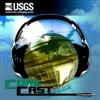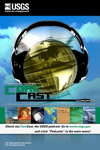USGS CoreCast
USGS Podcasts Home > CoreCast Home Page
Can't see Flash? Install Flash Player.
|
42
|

A roundup of the previous month's hazard-related events around the world, with some newsworthy tidbits.
Type: audio/mpeg
File Size: 3676126 bytes Duration: 3:45 Released: Fri, 2 May 2008 15:17:12 UTC |
Transcript:
[Music fades in and out.]
Hello and welcome—I'm Dave Hebert, and this is Episode 42 of the USGS CoreCast, the Hazards Roundup for April 2008. So what are some of the natural hazard happenings for April? Let's take a look.
We'll start off with earthquakes, where one of the bigger stories was that magnitude 5.2 earthquake in southern Illinois on April 18th. You can actually learn more about that one in episode 41 of CoreCast, which is the episode right before this one.
There's also been a swarm of earthquakes mostly in the magnitude-3 and -4 range off the coast of Oregon for a few weeks now, and quite a few in the mostly magnitude-3 range in Nevada near Reno.
In other parts of the world, the Loyalty Islands, Vanuatu, and Tonga, all east of Australia in the South Pacific, saw several earthquakes in the magnitude-6 and -7 range.
There was also a magnitude 7.1 near MacQuarie Island, which is more less between Australia and An . . . Antarctica—excuse me. So that part of the world was pretty busy.
On a related note, there were no tsunami warnings or watches issued in April, which is not a bad thing.
As long as we're talking tectonic plate stuff here, let's get into volcanoes. Kilauea continued to do its thing, producing ash, sulfur dioxide, and seismic tremors at the summit, while lava continued to flow into the ocean on the east rift eruption site. Episode 35 of CoreCast actually covers the new activity at Kilauea.
Other volcanoes in the U.S. and its territories that saw activity in April include Cleveland and—let me take a stab at this here—Veniaminof Volcanoes up Alaska way, Anatahan in the Northern Mariana Islands, and of course that lava dome at Mount St. Helens continues to grow.
Moving on to landslides . . . some Midwest and Plains States continued to see heavy rain in April, and as a result, there were landslides in Illinois, Missouri, and Oklahoma. Heavy snowfall and subsequent melting also lead to landslides near Vail, Colorado.
Elsewhere in the world, a landslide in Papua New Guinea blocked a major highway and actually led to a fuel shortage and a hike in food prices in one region. In China, landslides caused by heavy rain led to the evacuation of 200 people near Three Gorges Dam, which, if you don't know, is the largest hydroelectric project in the world. And finally and tragically, three people were killed by landslides in Port-Au-Prince, Haiti.
While we're talking about precipitation-related hazards, let's get to floods. We've had ongoing flooding along the Mississippi River. The lower Mississippi in particular has seen its largest flooding since 1973, with flow measuring 1.8 million cubic feet per second, which is enough water to fill more than 20 Olympic-size swimming pools in one second, or more than 1.75 million pools in a day.
We've also had flooding in Arkansas, Oklahoma, Indiana, Illinois, and now Maine, as well, right toward the end of April.
In wildfires, we had a list of States reporting large fires through the end of April, including Arizona, California, Florida, North Carolina, New Mexico, Tennessee, and Texas.
Well, that is a wrap for this month's Hazards Roundup. Learn more about all of these hazards at usgs.gov/hazards. And for bite-sized science Q&A podcasts on many of these topics, check out CoreFacts at usgs.gov/corefacts. C-o-r-e-f-a-c-t-s. CoreFacts is short on time, and big on science, as we like to say.
CoreCast is a product of the U.S. Geological Survey, Department of Interior. Until next time, I'm Dave Hebert. Thank you for listening, and take it easy.
[Music fades in and out.]
Music credit:
"Ground Control" by rimela
Resources related to this episode:
- USGS Hazards Gateway
- USGS CoreFacts
- CoreCast Ep. 35: Dramatic Developments at Kilauea
- Highest Flood Recorded on Lower Mississippi River Since 1973


